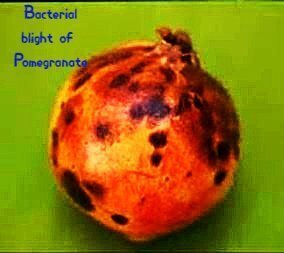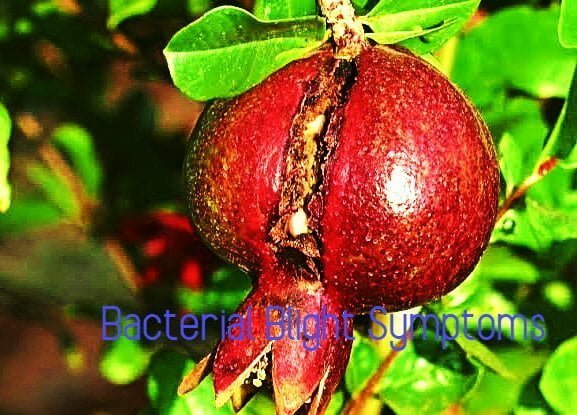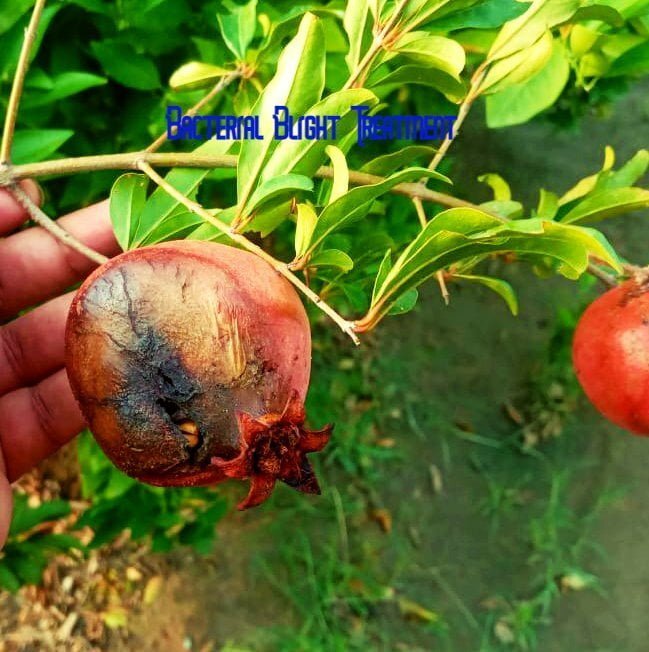Bacterial Blight of Pomegranate
The bacterial blight of pomegranate is one of the most dangerous diseases of pomegranate. Bacterial blight disease reduces the production of fruit by 30 to 50%. Pomegranate disease is triggered by the fungal pathogen Xanthomonas xonopodis. The pathogens enter the plant’s fruit through wounds and stomata, affecting the plants.
Bacterial Blights How to Diagnose
The symptoms of blight on leaves, stems, and fruits have been previously described. Pathogens (bacteria) can be identified by viewing a sample of sick tissue mounted in a drop of water on a glass slide under a microscope for signs of bacterial slime. Bacterial slime attests to the close relationship between the diseased plant portion and the blight bacterium. Pathogens can also be found and identified using molecular techniques like a polymerase chain reaction.
What is Bacterial blight?

The bacterial blight of pomegranates is one of the most dangerous diseases of pomegranates. Bacterial blight disease reduces the production of fruit by 30 to 50%. Pomegranate disease is triggered by the fungal pathogen Xanthomonas xonopodis. The pathogens enter the plant’s fruit through wounds and stomata, affecting the plants.
Bacterial Blight Symptoms

- Bacterial blight of pomegranate symptoms, black and brown spots appear on the leaves.
- Branches that are more attacked to disease break off.
- Star-shaped black spots appear on the fruit.
Symptoms on Leaves
Tiny water droplets Foliage shows wet lesions that darken to black with a translucent halo around a necrotic core over time. The presence of a translucent halo, however, may be obscured in more advanced lesions. Occasionally, lesions will consolidate, and they will spread along veins and the midrib. The yellowing and premature drop of leaves are common symptoms of infection.
Symptoms of the Stems
Twigs and stems show brownish-black lesions that begin at the nodes and progress along the bark. Infections are usually found in the bark and cortex but can extend to the vascular region. Blight lesions on twigs often cause girdling, resulting in the twig breaking off at the point of infection. Such twigs dry out and become yellow, remaining connected to the plant until dislodged by external pressure. Since blight infections are prominent at nodes, the disease is also called nodal blight, while in Maharashtra it’s called oily spot. Old infections, especially on the main stem and branches, rarely cause cankers, limiting the pathogen’s spread.
Symptoms of Fruits
Initial bacterial blight of pomegranate signs on fruits is little watersoaked lesions that grow and develop necrotically. Lesions on fruits often expose Y- or L-shaped tiny fissures, which aren\’t seen with Cercospora sp. Fruit lesions often combine and cause blight. Lesions on blighted fruits cause splitting, making them unfit for ingestion.
Bacterial Blight Spread
The bacterium spreads from the source of the inoculum to healthy plants and new orchards through rain splashes, irrigation water, pruning tools, infected planting material, insect vectors, and man. Pomegranate butterflies, aphids, blister beetles, and fruit borer larvae are insect vectors of the blight bacterium. Pathogens infect plants by stomata, lenticels, hydathodes, or wounds.
The bacterium’s incubation duration varies by host and environment. Hingorani saw disease symptoms in two-month-old pomegranate cuttings 9 and 12 days after inoculating wounded and unharmed plant portions. Kanwar established pathogenicity on different plant sections by inoculating them with and without injury. Infected parts developed symptoms in 4 to 7 days, while uninjured parts required 8 to 12 days. Kishun discovered the leaf-cut method to be the best where the infection was 100% and covered 70 to 90% leaf area after 21 days.
Automation of bacterial suspension induced the lowest infection (6 to 75%) with the greatest incubation period of 17 to 40 days. Rani observed blight signs in injured flowers, fruits, and leaves 7 to 10 days after incubation, but unharmed parts took 12 to 15 days. Symptoms of blight first appeared on the abaxial surface of inoculated leaves after 3 days at 26.0o C in damp conditions. In another study, different methods of inoculation were evaluated on potted plants to get a suitable method for screening germplasm against bacterial blight.
Though symptoms were produced between 8 and 15 days of inoculations in different treatments, disease severity increased after 15 days in all the methods with or without injury, revealing the use of simple spray as suitable for screening germplasm. Mogle saw blight symptoms on wounded leaves 9 to 13 days after inoculation. The bacterial blight disease is spread by rainwater, labor workers, and insects.
Bacterial Blight Management

Recent successful management of bacterial blight of pomegranate has arisen from the use of an integrated set of practices that incorporates cultural practices, sanitation measures, and chemical control strategies.
Bacterial Blight Control Through Cultural Practice
- To prevent infections in a new orchard, it is crucial to source blight-free and healthy planting material from seemingly blight-free nurseries.
- For bacterial blight disease treatment, spray the Bordeaux mixture 1%.
- Take unique initiative to keep the garden clean.
- Cut off the affected fruit, break off the leaves, and bury or burn them.
- As well as spray copper hydroxide 25g per acre.
Bacterial Blight Chemical Control Method
Controlling blight and increasing quality fruit production by 82.2% with a spray schedule with Streptocycline (500 ppm) alone or in combination with fungicides such as copper oxychloride (0.2%)/carbendazim (0.1%) at a 15-day interval (Anonymous 2008). Bactronol (2-Bromo-2-Nitro propane-1,3-diol) antibiotic at 500 ppm combined with copper oxychloride (0.2%) is another regimen that effectively reduces blight. Sprays containing 500 ppm Streptocycline and 0.2% copper oxychloride, or 500 ppm Bromopal and 0.2% copper oxychloride, successfully controlled blight and increased yield.
